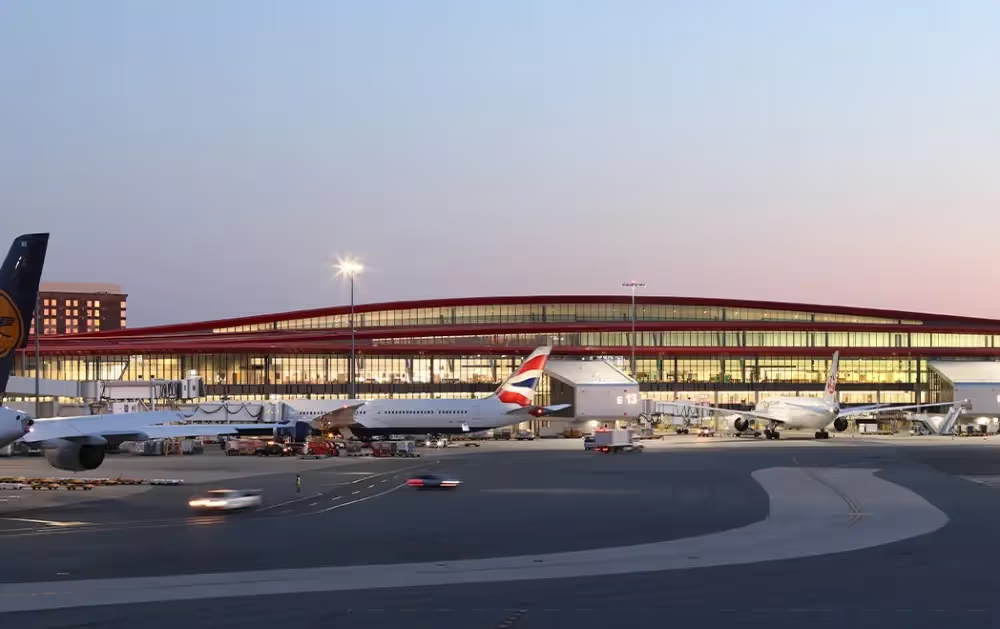The opening of Boston Logan International Airport’s long-anticipated, multi-million-dollar expansion surprisingly flew under the radar.
The 320,000-square-foot, $640 million Terminal E expansion quietly debuted with a soft opening in August 2023. A grand opening ceremony followed in October, and the terminal fully opened in April of 2024.
The visually striking terminal was compared to a ruby-red intergalactic spaceship in the Boston Globe due to its prismatic red roof that subtly changes color depending on the light. Inside, the terminal features four additional gates, restaurants, a duty-free shop, and one of Delta Air Lines’ posh Sky Clubs: lounges exclusively for those flying first or business class on Delta or one of its partner airlines.

The building isn’t just aesthetically innovative; designed by AECOM and Luis Vidal + Architects, the expansion features green technologies such as photovoltaic glass – which converts ultraviolet and infrared light to electricity – and incorporates recycled materials to help minimize greenhouse gas emissions. Its critical infrastructure is elevated above the flood plain for resilience, its roof and envelope go beyond code minimums to withstand snow, ice, rainwater and high winds from a 500-year storm, and its overall shape was designed to serve as a noise barrier shielding the sound of planes and airport operations from the nearby East Boston.
According to a statement on AECOM’s website, the efforts to make the terminal energy-efficient resulted in a 25% reduction of qualified energy use above that required by the Massachusetts Energy Code.
“Massport (Massachusetts Port Authority) conceived the new Terminal E as a modern, iconic, international terminal that elevates Logan Airport’s reputation for providing an enhanced passenger experience,” AECOM Principal Architect and Senior Vice President Terry Rookard told Engineering News-Record.
The Terminal E project had to overcome numerous hurdles to reach completion. Some of those challenges – like pandemic-related delays – couldn’t be anticipated. Others – such as the fact that the airport remained active throughout construction – were expected, and, according to the project team, required heightened levels of collaboration, transparency and planning among stakeholders to conquer.
“The result is a bold, striking building designed with sustainable principles and focused on providing a unique, comfortable and healthy environment for passengers and workers alike,” Luis Vidal told ENR.

Keep Your Projects On Time, On Budget, and Safe
Whether you’re overseeing an expansion to an international airport, or installing fiber optic cable in a suburban neighborhood, the best way to keep your projects on track is to mitigate the risk of subsurface damage while digging and ensure seamless communication between all stakeholders from start to finish.
The top six root causes driving nearly 76% of all reported damages have remained consistent year-over-year, according to data found in the Common Ground Alliance’s 2022 DIRT Report. Those causes include “No notification made to 811 One-Call Center,” “Facility not marked due to locator error,” “Excavator failed to maintain clearance after verifying marks,” “Marked inaccurately due to locator error,” “Improper excavation practice not listed elsewhere,” and “Excavator dug prior to verifying marks by potholing.”
“This year’s insights underscore consistent priority action areas that will significantly reduce damages,” CGA President & CEO, Sarah K. Magruder Lyle, wrote in the report. “For facility owners, GIS-based mapping of assets and communication are urgently needed to improve locating timelines and accuracy. Construction, maintenance, installation and locating contracts must incentivize adherence to Best Practices and drive damage reductions. Excavators must double down on safe work practices and proper use of 811. Expanded enforcement and education programs are essential to motivate compliance…”
GPRS offers a suite of subsurface damage prevention, existing conditions documentation, and construction & facilities project management services designed to protect your assets and people. From precision concrete scanning and utility locating to 3D laser scanning, video pipe inspections and virtual tours, we strive to keep your projects on time, on budget, and safe.
To put this field-verified data at your fingertips 24/7, GPRS created SiteMap® (patent pending), our cloud-based project & facility management application that provides accurate existing condition documentation to help you plan, design, manage, dig, and ultimately build better.
GPRS’ SiteMap® team members are currently scheduling live, personal demonstrations. Click below to schedule your free SiteMap® demo today!
Frequently Asked Questions
What are sustainable building practices?
Sustainable building practices involve designing, constructing, and operating buildings in a way that reduces their environmental impact. This includes using energy-efficient materials, reducing waste, conserving water, and incorporating renewable energy sources. The goal is to create buildings that are environmentally responsible, resource-efficient, and healthy for occupants.
What are the benefits of sustainable building practices?
The benefits of sustainable building practices include lower energy and water costs, reduced waste, improved indoor air quality, and enhanced occupant health and productivity. Additionally, sustainable buildings often have a smaller carbon footprint and contribute to the overall sustainability goals of a community or organization. These practices can also increase the market value of properties and provide a competitive advantage in the real estate market.
What are some common strategies used in sustainable building practices?
Common strategies include using renewable energy sources such as solar or wind power, implementing energy-efficient lighting and HVAC systems, using sustainable materials like recycled or locally sourced products, and incorporating green roofs or walls. Additionally, sustainable building practices often involve water conservation techniques, such as low-flow fixtures and rainwater harvesting, as well as designing buildings to maximize natural light and ventilation.
